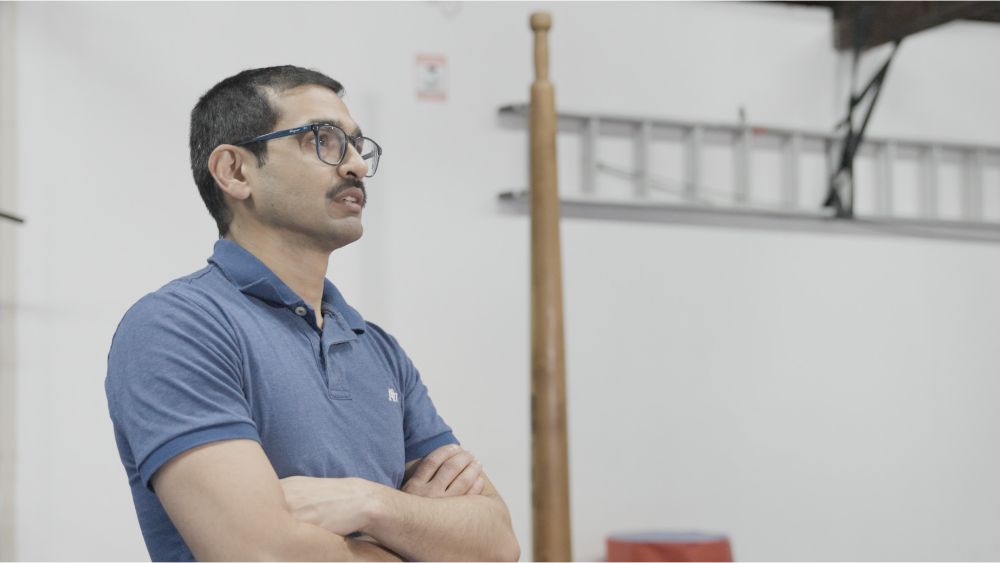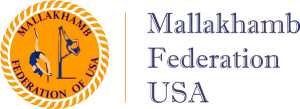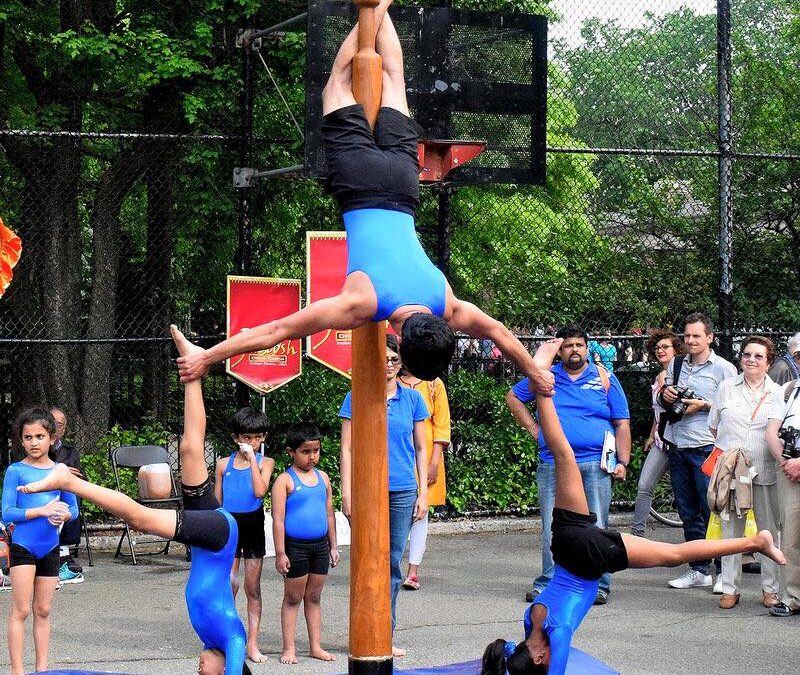While Mallakhamb may be lesser-known outside of India, its benefits for gymnasts are undeniable. Core strength forms the foundation of gymnastics prowess. Practicing Gymnastics with Mallakhamb can significantly improve flexibility, balance, coordination, and most importantly, core strength.
Whether you’re executing a graceful balance beam routine or launching yourself into a powerful vault, a strong core is essential for stability and control. In gymnastics, the core muscles— including the abdominals, obliques, and lower back— play a crucial role in maintaining proper body alignment, generating explosive power, and executing complex movements with precision.
The demanding nature of Gymnastics with Mallakhamb exercises challenges every muscle in the body, making it an excellent cross-training tool for gymnasts looking to enhance their performance.
In this particular article, we’ll find out how Mallakhamb for gymnastics training can specifically target and strengthen these core muscles, ultimately helping gymnasts master their craft and reach new heights of performance.
Importance of Core Strength in Gymnastics
Why Core Strength is Essential for Gymnasts
Core strength is the secret weapon behind every successful gymnast’s performance. Think of your core muscles as the powerhouse of your body, providing the strength and stability needed to execute those awe-inspiring routines with finesse.
From holding difficult positions on the balance beam to achieving perfect form during a handstand, a strong core is fundamental to mastering gymnastics skills.
The Impact of Core Stability on Gymnastics Performance
Core stability goes hand in hand with gymnastics performance. When your core muscles are strong and stable, they act as a solid foundation, allowing you to maintain proper body alignment and control your movements with precision.
This translates to better balance, improved coordination, and the ability to generate maximum power while minimizing the risk of injury. Essentially, a strong core enhances every aspect of your gymnastics performance, from graceful flexibility to explosive strength.
Common Core Strength Challenges Faced by Gymnasts
Gymnasts often encounter specific challenges when it comes to core strength. One common issue is the imbalance between different muscle groups within the core, leading to instability and decreased control over movements.
Additionally, inadequate core strength can result in compensatory movements, where other muscles try to take over, increasing the risk of strain and injury. Understanding and addressing these challenges are crucial steps in optimizing core strength with gymnastics and maximizing gymnastics performance.
Understanding Core Muscles Used in Gymnastics
The core muscles play a vital role in gymnastics, providing the strength and stability needed to perform various movements with precision and control.
Some key muscles in the core include the
- Rectus abdominis (front of the abdomen)
- Obliques (sides of the abdomen)
- Transverse abdominis (deep core muscles)
- Erector spinae (lower back muscles)
These muscles work together to support the spine, maintain posture, and facilitate dynamic movements essential for gymnastics routines.
During gymnastics routines, core muscles are constantly engaged to stabilize the body and control movements. For example, when performing a handstand, the core muscles help maintain a straight body position and prevent the legs from collapsing.
Similarly, during a backflip or a somersault, strong core muscles provide the power needed to initiate and control the rotation, ensuring a smooth and controlled landing.
To enhance gymnastics performance, it’s essential to target specific core muscles through targeted exercises. Core exercises like planks, leg raises, Russian twists, and hollow body holds are effective for strengthening different areas of the core.
By focusing on these exercises and incorporating them into regular training routines, gymnasts can improve core strength, stability, and overall performance on the mat or apparatus.
How Mallakhamb Enhances Core Strength
Let’s understand the science behind Mallakhamb, and how it builds core strength. Mallakhamb’s unique combination of strength, balance, and agility makes it an excellent tool for developing core strength with gymnastics.
Mallakhamb Core exercises, performed on a vertical wooden pole or rope, require constant engagement of the core muscles to maintain balance and control. As gymnasts practice various Gymnastics with Mallakhamb poses and transitions, they gradually strengthen their core muscles, resulting in improved stability and control over their movements.
Mallakhamb vs. Traditional Core Training: Key Differences
While traditional core training exercises like crunches and sit-ups can be effective, Mallakhamb offers a more dynamic and functional approach to core strength development. Unlike static Core exercises performed on the ground, Gymnastics with Mallakhamb exercises challenge the core muscles in multiple planes of motion, mimicking the dynamic movements required in gymnastics routines.
Athletes who incorporate Gymnastics with Mallakhamb into their training regimens often report improvements in core stability, balance, and overall strength, translating to enhanced performance on the gymnastics floor.
Additionally, research studies have shown that Mallakhamb training can lead to significant gains in core muscle strength, highlighting its effectiveness as a cross-training tool for gymnasts.
Core-Strengthening Gymnastics Exercises
In Gymnastics with Mallakhamb exercises, there are several Core exercises specifically designed to target and strengthen the core muscles, essential for mastering various routines and skills. One fundamental exercise is the hollow body hold, where the practitioner lies on their back, arms extended overhead, and lifts both the upper and lower body off the ground, engaging the core muscles throughout.
This exercise builds strength in the abdominals and lower back while promoting proper body alignment, crucial for executing skills on the floor, beam, or bars. Additionally, exercises like leg lifts, Russian twists, and planks are effective for targeting different areas of the core and improving overall stability and control.
Step-by-Step Guide to Performing Core-Targeted Gymnastics Exercises
Performing core-targeted gymnastics exercises requires attention to proper form and technique. For example, to execute a hollow body hold effectively, lie on your back with arms extended overhead and legs straight out.
- Engage the core by pressing the lower back into the floor and lifting both the upper and lower body off the ground, forming a “hollow” position.
- Hold this position for a few seconds, focusing on maintaining tension in the core muscles, before lowering back down.
- Repeat for multiple sets to build endurance and strength in the core.
Gymnastics exercises can be adapted and modified to suit practitioners of all skill levels, from beginners to advanced athletes. Beginners may start with simpler variations of exercises, focusing on mastering proper form and technique before progressing to more advanced movements.
For example, beginners can perform modified versions of leg lifts or planks, gradually increasing the intensity and duration as they build strength and confidence.
As practitioners progress, they can explore more challenging variations and progressions, such as adding resistance or incorporating dynamic movements, to continue challenging the core muscles and promoting continued improvement in strength and stability.
Tips for Proper Form and Technique in Gymnastics
Maintaining proper alignment and posture is essential for safe and effective gymnastics training. Practitioners should strive for a neutral spine position and avoid overarching or rounding of the back, which can lead to strain or injury.
Engaging the core muscles throughout each exercise helps stabilize the spine and promote proper body alignment, enhancing overall performance and reducing the risk of injury.
By focusing on proper form and technique, practitioners can optimize their gymnastics training experience and maximize the benefits for core strength and stability.
Key Mallakhamb Techniques for Maximizing Core Engagement in Gymnastics Exercises
- To maximize core engagement in gymnastics exercises, practitioners should focus on activating the deep core muscles, such as the transverse abdominis and pelvic floor muscles.
- Visualizing drawing the navel towards the spine and engaging the muscles around the waistline can help create stability and support during Core exercises.
- Additionally, maintaining a steady breathing pattern is crucial for facilitating core activation and maintaining control over movements.
Common Mistakes to Avoid When Practicing Gymnastics for Core Strength
When practicing gymnastics for core strength, it’s important to avoid common mistakes that can compromise form and increase the risk of injury.
- One common mistake is allowing the lower back to arch excessively during exercises, which can strain the spine and diminish the effectiveness of core engagement.
- Practitioners should aim to maintain a neutral spine position throughout each exercise, focusing on proper alignment and posture.
- Additionally, rushing through exercises or sacrificing form for intensity should be avoided, as this can lead to sloppy technique and reduced benefits.
Integrating Mallakhamb Core Workouts into Gymnastics Training
Incorporating Mallakhamb into gymnastics training sessions can improve Mallakhamb for Gymnastics Core Strength and overall performance. One strategy is to dedicate specific portions of training sessions to Mallakhamb exercises, either as a warm-up or as supplementary strength training.
For example, gymnasts can start their session with dynamic Gymnastics with Mallakhamb poses to activate the core muscles before transitioning to gymnastics skills practice. Additionally, integrating Mallakhamb into circuit training or interval workouts allows gymnasts to reap the benefits of both disciplines in a single session.
Designing hybrid workouts that combine Mallakhamb and gymnastics exercises can provide a comprehensive training experience. Begin by selecting a variety of Mallakhamb poses and gymnastics skills that target the core muscles from different angles and movement patterns.
Alternate between Mallakhamb poses and gymnastics skills within the workout, allowing for adequate rest between sets to maintain intensity and focus. By incorporating both disciplines into a cohesive training plan, gymnasts can develop well-rounded core strength and improve their gymnastics performance.
Balancing Mallakhamb and Gymnastics Training Schedules for Optimal Results
Balancing Gymnastics with Mallakhamb training schedules is essential for achieving optimal results without overtraining or burnout. Consider integrating Mallakhamb workouts into the gymnastics training schedule in a way that complements rather than detracts from gymnastics skill development.
For example, schedule Gymnastics with Mallakhamb sessions on rest days or during lighter training weeks to prevent excessive fatigue and allow for adequate recovery. Additionally, communicate with coaches and trainers to ensure that Mallakhamb training aligns with the overall gymnastics training plan and goals.
Progressive Core Training Strategies with Mallakhamb
To continuously challenge the core muscles with Mallakhamb, incorporate progressive overload principles into training sessions. Gradually increase the intensity, duration, or complexity of Mallakhamb poses and exercises over time to stimulate muscle growth and adaptation.
For example, progressively increase the duration of holds in static poses or add resistance to dynamic movements to increase the challenge to the core muscles. By consistently pushing the limits of core strength for Gymnastics with Mallakhamb, gymnasts can achieve ongoing improvements in performance.
Implementing periodization Mallakhamb techniques into Mallakhamb core training programs can optimize progress and prevent plateaus. Divide training cycles into specific phases, such as strength, endurance, and recovery, each with its own focus and intensity level.
During the strength phase, prioritize heavy resistance and high-intensity Gymnastics with Mallakhamb exercises to build muscle strength and power. In the endurance phase, emphasize longer-duration holds and dynamic movements to improve core stamina and muscular endurance.
Incorporate recovery periods between training cycles to allow for physical and mental rejuvenation, ensuring that gymnasts can sustain long-term progress and performance improvements.
Tips for Monitoring Progress and Adjusting Mallakhamb Core Workouts
Monitoring progress and adjusting Gymnastics with Mallakhamb core workouts is essential for maintaining momentum and preventing stagnation.
- Keep track of key performance metrics, such as hold times, repetitions, or resistance levels, to gauge improvements over time.
- Regularly reassess goals and adjust workout intensity or volume accordingly to continue challenging the core muscles and promoting growth.
- Listen to your body and be mindful of signs of fatigue or overtraining, adjusting workout schedules or intensity as needed to prioritize recovery and prevent injury.
Tracking Progress and Adjusting Mallakhamb Core Workouts
To improve core strength with gymnastics with Mallakhamb, it’s essential to set specific, measurable goals that provide clear direction and motivation.
Examples of measurable goals include increasing hold times in static poses, performing a certain number of repetitions in dynamic exercises, or improving overall endurance during Gymnastics with Mallakhamb workouts.
By establishing achievable yet challenging goals, gymnasts can track their progress effectively and stay focused on continuous improvement.
Tools and Methods for Tracking Core Strength Progression
Various tools and methods can help gymnasts track their core strength progression with Mallakhamb. Keeping a training journal or log allows gymnasts to record workout details, including exercises performed, sets, repetitions, and any adjustments made.
Additionally, using fitness apps or wearable devices that track metrics such as heart rate, duration, and intensity of Mallakhamb workouts can provide valuable insights into performance and progress over time.
Regular assessments, such as strength tests or body composition measurements, can also help gauge improvements in Gymnast Core Strength and overall fitness.
Based on performance feedback and progress tracking, gymnasts can make informed adjustments to their Gymnastics with Mallakhamb core workouts to optimize effectiveness and prevent plateaus.
If progress stalls or goals are not being met, consider increasing the intensity or volume of workouts by adding more challenging poses, increasing resistance, or incorporating new variations.
Conversely, if fatigue or overtraining becomes a concern, scale back intensity or duration, prioritize rest and recovery, and focus on maintaining proper form and technique.
By staying flexible and responsive to performance feedback, gymnasts can ensure that Mallakhamb core workouts continue to drive progress and deliver results.
Conclusion
Throughout this blog, we’ve explored the synergistic relationship between Mallakhamb and gymnastics, focusing on how Mallakhamb core training can enhance gymnasts’ performance. From understanding the importance of core strength in gymnastics to implementing progressive training strategies for Gymnastics with Mallakhamb, we’ve covered essential concepts and practical tips for integrating Mallakhamb into gymnastics training.
Mallakhamb offers unique benefits for gymnasts, providing a dynamic and effective way to strengthen the core muscles essential for success in the sport. By embracing Mallakhamb for gymnastics training as a vital component of their training regimen, gymnasts can unlock new levels of strength, stability, and performance potential.
As they continue their Mallakhamb Core exercises journey, they’ll not only elevate their gymnastics performance but also cultivate resilience, discipline, and confidence that extend beyond the gym.
I encourage gymnasts to embrace Mallakhamb training as a vital component of their quest for excellence in gymnastics. Whether you’re a beginner looking to build a solid foundation of Gymnast Core Strength or an experienced athlete seeking to take your performance to the next level, Mallakhamb for gymnastics offers endless opportunities for growth and improvement.
FAQs
1. How does gymnastics, along with Mallakhamb, contribute to building overall strength?
Gymnastics and Mallakhamb both utilize bodyweight resistance and dynamic movements to develop strength.
2.Is the combination of gymnastics and Mallakhamb effective for improving core strength?
Yes, integrating gymnastics and Mallakhamb exercises engages the core muscles comprehensively for improved strength.
3. How do gymnasts incorporate Mallakhamb into their core training routines alongside gymnastics?
Gymnasts seamlessly integrate Mallakhamb for gymnastics poses and exercises into their Core exercises regimen to enhance strength and stability.
4. Do gymnasts specifically focus on training their abdominal muscles using Mallakhamb?
Yes, gymnasts utilize Mallakhamb exercises to target and strengthen the abdominal muscles as part of their core training.


